Showing Spotlights 873 - 880 of 2788 in category All (newest first):
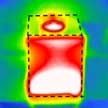 With the exponential rise of power dissipation in electric devices such as integrated circuits or micro/nano electro mechanical systems (MEMS/NEMS), new thermal management solutions are in high demand. Thermal switches, being devices capable of controlling the temperature flow between two surfaces, are one of the solutions capable of effectively tackling this problem. In new work, researchers demonstrate an innovative magnetically actuated thermal switch based on nanofluids capable of controlling both the magnitude and direction of the heat flux. This device takes advantage of the thermal conductivity increase in magnetic nanofluids when submitted to an applied magnetic field parallel to the temperature gradient.
With the exponential rise of power dissipation in electric devices such as integrated circuits or micro/nano electro mechanical systems (MEMS/NEMS), new thermal management solutions are in high demand. Thermal switches, being devices capable of controlling the temperature flow between two surfaces, are one of the solutions capable of effectively tackling this problem. In new work, researchers demonstrate an innovative magnetically actuated thermal switch based on nanofluids capable of controlling both the magnitude and direction of the heat flux. This device takes advantage of the thermal conductivity increase in magnetic nanofluids when submitted to an applied magnetic field parallel to the temperature gradient.
Dec 9th, 2016
 Methanol fuel cells are widely considered as a potential source of future energy due to the usage of methanol as a liquid fuel; simplicity in operation; higher energy density of methanol fuel; high power density obtained etc. However their commercialization is greatly hindered by methanol crossover taking place in the membrane area of fuel cells, leading to short circuits and greatly affecting overall performance. By using two-dimensional (2D) materials - graphene and hexagonal boron nitride (hBn) - in methanol fuel cell systems, researchers now have overcome this bottleneck.
Methanol fuel cells are widely considered as a potential source of future energy due to the usage of methanol as a liquid fuel; simplicity in operation; higher energy density of methanol fuel; high power density obtained etc. However their commercialization is greatly hindered by methanol crossover taking place in the membrane area of fuel cells, leading to short circuits and greatly affecting overall performance. By using two-dimensional (2D) materials - graphene and hexagonal boron nitride (hBn) - in methanol fuel cell systems, researchers now have overcome this bottleneck.
Dec 7th, 2016
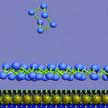 Following up on previous theoretical predictions, researchers now have demonstrated two high-yield methods for fabricating antimonenes - wide-band-gap semiconductors that under strain become direct band-gap semiconductors. Such dramatic transitions of electronic properties could open a new door for nanoscale transistors with high on/off ratio, blue/UV optoelectronic devices, and nanomechanical sensors based on new ultrathin semiconductors. The new approach is generic for various transparent conducting oxides as well as other oxide nanocrystal inks.
Following up on previous theoretical predictions, researchers now have demonstrated two high-yield methods for fabricating antimonenes - wide-band-gap semiconductors that under strain become direct band-gap semiconductors. Such dramatic transitions of electronic properties could open a new door for nanoscale transistors with high on/off ratio, blue/UV optoelectronic devices, and nanomechanical sensors based on new ultrathin semiconductors. The new approach is generic for various transparent conducting oxides as well as other oxide nanocrystal inks.
Dec 5th, 2016
 The growing need for 'green' energy sources combined with silicon solar cells' stagnating power conversion efficiencies have lead to a keen search for an alternative to silicon that would bring about a major change. Perovskite solar cell technology, boasting potential for high efficiency, low-cost scalable photovoltaic solar cells, may just be a suitable contender in this race. Perovskites, a class of materials that share a similar structure, display a myriad of exciting properties that position them as attractive candidates for enabling low-cost, efficient photovoltaics that could even be sprayed onto rooftops and various other surfaces.
The growing need for 'green' energy sources combined with silicon solar cells' stagnating power conversion efficiencies have lead to a keen search for an alternative to silicon that would bring about a major change. Perovskite solar cell technology, boasting potential for high efficiency, low-cost scalable photovoltaic solar cells, may just be a suitable contender in this race. Perovskites, a class of materials that share a similar structure, display a myriad of exciting properties that position them as attractive candidates for enabling low-cost, efficient photovoltaics that could even be sprayed onto rooftops and various other surfaces.
Dec 1st, 2016
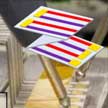 Flexible thermoelectric generators that are capable of producing electricity out of a temperature difference could have many applications in consumer and medical electronics. However, conventional thermoelectric materials are rigid and brittle and don't lend themselves to be used with flexible devices. Researchers have now demonstrated a flexible paper-based devices can be easily stacked or efficiently folded and cut through origami and kirigami techniques so that it is possible to achieve higher power densities. This allows for enough electricity to be generated to supply low-power systems, especially in applications where flexibility is advantageous, such as robotics, cybernetics, wearable devices or bio-integrated systems.
Flexible thermoelectric generators that are capable of producing electricity out of a temperature difference could have many applications in consumer and medical electronics. However, conventional thermoelectric materials are rigid and brittle and don't lend themselves to be used with flexible devices. Researchers have now demonstrated a flexible paper-based devices can be easily stacked or efficiently folded and cut through origami and kirigami techniques so that it is possible to achieve higher power densities. This allows for enough electricity to be generated to supply low-power systems, especially in applications where flexibility is advantageous, such as robotics, cybernetics, wearable devices or bio-integrated systems.
Nov 30th, 2016
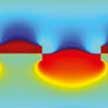 Metal nanoparticles can concentrate light near their surface through the excitation of surface plasmons, which are collective oscillations of electrons. Depending on the size and shape of the metal particles, surface plasmons can show a range of different optical responses and colors. In new work, researchers have now achieved narrow optical resonances and tailoring of the plasmonic resonance within a single system. Since each mode can be independently optimized depending on the stretching direction, their single system can cover a large wavelength bandwidth and meet specific application requirements at the same time.
Metal nanoparticles can concentrate light near their surface through the excitation of surface plasmons, which are collective oscillations of electrons. Depending on the size and shape of the metal particles, surface plasmons can show a range of different optical responses and colors. In new work, researchers have now achieved narrow optical resonances and tailoring of the plasmonic resonance within a single system. Since each mode can be independently optimized depending on the stretching direction, their single system can cover a large wavelength bandwidth and meet specific application requirements at the same time.
Nov 29th, 2016
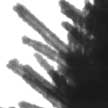 Lithium-sulfur (Li-S) batteries, which employ sulfur as cathode and metallic lithium as anode materials, have been extensively studied as promising alternatives to the widely used lithium-ion batteries because - theoretically - they can render 3-6 times higher energy density than conventional lithium-ion batteries. However, due to the intrinsic insulating nature of the active material (sulfur and lithium sulfide), Li-S batteries have suffered from low utilization of sulfur and thus low energy density. In new work, researchers have designed coaxial nanotubes with adjustable content of MnO2 to encapsulate sulfur as a high-performance cathode for Li-S batteries.
Lithium-sulfur (Li-S) batteries, which employ sulfur as cathode and metallic lithium as anode materials, have been extensively studied as promising alternatives to the widely used lithium-ion batteries because - theoretically - they can render 3-6 times higher energy density than conventional lithium-ion batteries. However, due to the intrinsic insulating nature of the active material (sulfur and lithium sulfide), Li-S batteries have suffered from low utilization of sulfur and thus low energy density. In new work, researchers have designed coaxial nanotubes with adjustable content of MnO2 to encapsulate sulfur as a high-performance cathode for Li-S batteries.
Nov 24th, 2016
 A skin-like, wearable system combines colorimetric and electronic function for precise dosimetry in the UV-A and UV-B regions of the spectrum. This platform is suitable for determination of instantaneous UV exposure levels and skin temperature. Exposure to ultraviolet (UV) radiation is a major risk factor for most skin cancers. UV rays damage the DNA of skin cells. Skin cancers start when this damage affects the DNA of genes that control skin cell growth. Creating awareness in UV exposure is widely believed to be an important aspect in improving skin health.
A skin-like, wearable system combines colorimetric and electronic function for precise dosimetry in the UV-A and UV-B regions of the spectrum. This platform is suitable for determination of instantaneous UV exposure levels and skin temperature. Exposure to ultraviolet (UV) radiation is a major risk factor for most skin cancers. UV rays damage the DNA of skin cells. Skin cancers start when this damage affects the DNA of genes that control skin cell growth. Creating awareness in UV exposure is widely believed to be an important aspect in improving skin health.
Nov 23rd, 2016
 With the exponential rise of power dissipation in electric devices such as integrated circuits or micro/nano electro mechanical systems (MEMS/NEMS), new thermal management solutions are in high demand. Thermal switches, being devices capable of controlling the temperature flow between two surfaces, are one of the solutions capable of effectively tackling this problem. In new work, researchers demonstrate an innovative magnetically actuated thermal switch based on nanofluids capable of controlling both the magnitude and direction of the heat flux. This device takes advantage of the thermal conductivity increase in magnetic nanofluids when submitted to an applied magnetic field parallel to the temperature gradient.
With the exponential rise of power dissipation in electric devices such as integrated circuits or micro/nano electro mechanical systems (MEMS/NEMS), new thermal management solutions are in high demand. Thermal switches, being devices capable of controlling the temperature flow between two surfaces, are one of the solutions capable of effectively tackling this problem. In new work, researchers demonstrate an innovative magnetically actuated thermal switch based on nanofluids capable of controlling both the magnitude and direction of the heat flux. This device takes advantage of the thermal conductivity increase in magnetic nanofluids when submitted to an applied magnetic field parallel to the temperature gradient.
 Subscribe to our Nanotechnology Spotlight feed
Subscribe to our Nanotechnology Spotlight feed





